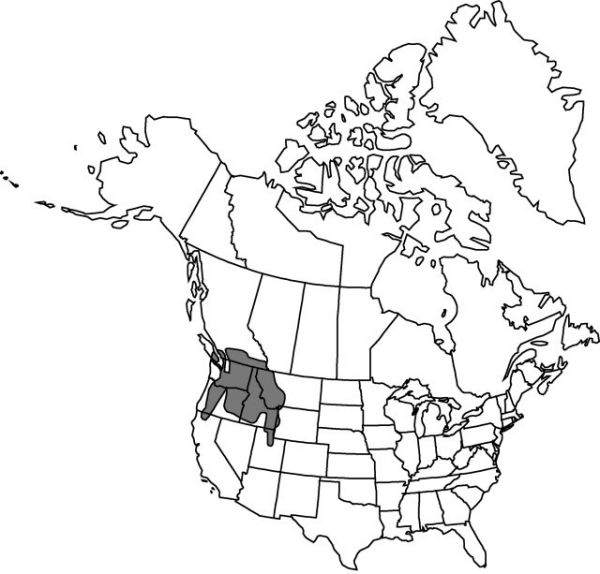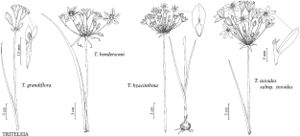Difference between revisions of "Triteleia grandiflora"
Edwards’s Bot. Reg. 15: under plate 1293. 1830.
FNA>Volume Importer |
FNA>Volume Importer |
||
| Line 15: | Line 15: | ||
|name=Brodiaea bicolor | |name=Brodiaea bicolor | ||
|authority=Suksdorf | |authority=Suksdorf | ||
| − | }}{{Treatment/ID/Synonym | + | }} {{Treatment/ID/Synonym |
|name=Brodiaea douglasii | |name=Brodiaea douglasii | ||
|authority=S. Watson | |authority=S. Watson | ||
| − | }}{{Treatment/ID/Synonym | + | }} {{Treatment/ID/Synonym |
|name=Brodiaea douglasii var. howellii | |name=Brodiaea douglasii var. howellii | ||
|authority=(S. Watson) M. Peck | |authority=(S. Watson) M. Peck | ||
| − | }}{{Treatment/ID/Synonym | + | }} {{Treatment/ID/Synonym |
|name=Brodiaea howellii | |name=Brodiaea howellii | ||
|authority=(Suksdorf) Piper | |authority=(Suksdorf) Piper | ||
| − | }}{{Treatment/ID/Synonym | + | }} {{Treatment/ID/Synonym |
|name=Hookera bicolor | |name=Hookera bicolor | ||
|authority=(S. Watson) Piper | |authority=(S. Watson) Piper | ||
| − | }}{{Treatment/ID/Synonym | + | }} {{Treatment/ID/Synonym |
|name=Hookera douglasii | |name=Hookera douglasii | ||
|authority=(Lindley) Kuntze | |authority=(Lindley) Kuntze | ||
| − | }}{{Treatment/ID/Synonym | + | }} {{Treatment/ID/Synonym |
|name=Hookera grandiflora | |name=Hookera grandiflora | ||
|authority=(S. Watson) Piper | |authority=(S. Watson) Piper | ||
| − | }}{{Treatment/ID/Synonym | + | }} {{Treatment/ID/Synonym |
|name=Hookera howellii | |name=Hookera howellii | ||
|authority=(Lindley) Baker | |authority=(Lindley) Baker | ||
| − | }}{{Treatment/ID/Synonym | + | }} {{Treatment/ID/Synonym |
|name=Milla grandiflora | |name=Milla grandiflora | ||
|authority=(Suksdorf) A. Heller | |authority=(Suksdorf) A. Heller | ||
| − | }}{{Treatment/ID/Synonym | + | }} {{Treatment/ID/Synonym |
|name=Triteleia bicolor | |name=Triteleia bicolor | ||
|authority=(S. Watson) Greene | |authority=(S. Watson) Greene | ||
| − | }}{{Treatment/ID/Synonym | + | }} {{Treatment/ID/Synonym |
|name=Triteleia grandiflora var. howellii | |name=Triteleia grandiflora var. howellii | ||
|authority=(S. Watson) Hoover | |authority=(S. Watson) Hoover | ||
| − | }}{{Treatment/ID/Synonym | + | }} {{Treatment/ID/Synonym |
|name=Triteleia howellii | |name=Triteleia howellii | ||
|authority=unknown | |authority=unknown | ||
| Line 63: | Line 63: | ||
|elevation=100–3000 m | |elevation=100–3000 m | ||
|distribution=B.C.;Calif.;Idaho;Mont.;Oreg.;Utah;Wash.;Wyo. | |distribution=B.C.;Calif.;Idaho;Mont.;Oreg.;Utah;Wash.;Wyo. | ||
| − | |discussion=<p>Triteleia grandiflora is the type species of the genus and, along with T. hyacinthina, is its most widely distributed member. Found throughout the region between the Cascade Range and the northern Rocky Mountains, in sagebrush steppe and adjacent woodlands, it is easily recognized by the shape of the perianth, which is rounded at the base instead of tapered as in other Triteleia species.</p><!-- | + | |discussion=<p><i>Triteleia grandiflora</i> is the type species of the genus and, along with <i>T. hyacinthina</i>, is its most widely distributed member. Found throughout the region between the Cascade Range and the northern Rocky Mountains, in sagebrush steppe and adjacent woodlands, it is easily recognized by the shape of the perianth, which is rounded at the base instead of tapered as in other <i>Triteleia</i> species.</p><!-- |
| − | --><p>M. E. Barkworth (1975, 1977) studied variation within Triteleia grandiflora in relation to ploidy level. Polyploid plants are larger, flower later, and have more effective vegetative reproduction by cormlets and contractile roots than their diploid progenitors.</p><!-- | + | --><p>M. E. Barkworth (1975, 1977) studied variation within <i>Triteleia grandiflora</i> in relation to ploidy level. Polyploid plants are larger, flower later, and have more effective vegetative reproduction by cormlets and contractile roots than their diploid progenitors.</p><!-- |
| − | --><p>Plants of Triteleia grandiflora from the area west of the Cascade Range and extending into the Columbia River valley and the Klamath Lake region that have been distinguished as var. howellii differ from others of the species only in the shape of the filaments. L. Abrams and R. S. Ferris (1923–1960, vol. 1) used relative perianth length as a key character, but this is not consistent (R. F. Hoover 1941), and several specimens from the part of the Columbia River valley where both filament morphologies occur appear to represent intergrades (R. F. Hoover 1955). Thus it seems inadvisable to recognize infraspecific taxa. Plants assignable to var. howellii have not been found in California or southwestern Oregon in recent decades, and may be extirpated there.</p><!-- | + | --><p>Plants of <i>Triteleia grandiflora</i> from the area west of the Cascade Range and extending into the Columbia River valley and the Klamath Lake region that have been distinguished as <i></i>var.<i> howellii</i> differ from others of the species only in the shape of the filaments. L. Abrams and R. S. Ferris (1923–1960, vol. 1) used relative perianth length as a key character, but this is not consistent (R. F. Hoover 1941), and several specimens from the part of the Columbia River valley where both filament morphologies occur appear to represent intergrades (R. F. Hoover 1955). Thus it seems inadvisable to recognize infraspecific taxa. Plants assignable to <i></i>var.<i> howellii</i> have not been found in California or southwestern Oregon in recent decades, and may be extirpated there.</p><!-- |
| − | --><p>Triteleia bicolor is merely a color form having a perianth with a blue tube and white lobe.</p> | + | --><p><i>Triteleia</i> bicolor is merely a color form having a perianth with a blue tube and white lobe.</p> |
|tables= | |tables= | ||
|references= | |references= | ||
| Line 90: | Line 90: | ||
|publication year=1830 | |publication year=1830 | ||
|special status= | |special status= | ||
| − | |source xml=https://jpend@bitbucket.org/aafc-mbb/fna-data-curation.git/src/ | + | |source xml=https://jpend@bitbucket.org/aafc-mbb/fna-data-curation.git/src/8f726806613d60c220dc4493de13607dd3150896/coarse_grained_fna_xml/V26/V26_693.xml |
|genus=Triteleia | |genus=Triteleia | ||
|species=Triteleia grandiflora | |species=Triteleia grandiflora | ||
Revision as of 16:46, 18 September 2019
Leaves 20–70 cm × 4–10 mm. Scape 20–75 cm, smooth. Flowers: perianth bluish purple to white, 17–35 mm, tube obtuse and rounded at base, 8–20 mm, lobes spreading, 9–13 mm; stamens attached alternately at 2 levels, unequal; filaments slender and somewhat triangular, wider toward base, or broad, 1–4 mm, apical appendages absent or present; anthers yellow or purple, 2–4 mm; ovary twice as long as stipe; pedicel 1–4 cm. 2n = 16, 24, 32, 40, 48, 56.
Phenology: Flowering spring–summer (Apr–Jul).
Habitat: Grasslands, sagebrush, pinyon-juniper woodlands, pine forests and hills
Elevation: 100–3000 m
Distribution

B.C., Calif., Idaho, Mont., Oreg., Utah, Wash., Wyo.
Discussion
Triteleia grandiflora is the type species of the genus and, along with T. hyacinthina, is its most widely distributed member. Found throughout the region between the Cascade Range and the northern Rocky Mountains, in sagebrush steppe and adjacent woodlands, it is easily recognized by the shape of the perianth, which is rounded at the base instead of tapered as in other Triteleia species.
M. E. Barkworth (1975, 1977) studied variation within Triteleia grandiflora in relation to ploidy level. Polyploid plants are larger, flower later, and have more effective vegetative reproduction by cormlets and contractile roots than their diploid progenitors.
Plants of Triteleia grandiflora from the area west of the Cascade Range and extending into the Columbia River valley and the Klamath Lake region that have been distinguished as var. howellii differ from others of the species only in the shape of the filaments. L. Abrams and R. S. Ferris (1923–1960, vol. 1) used relative perianth length as a key character, but this is not consistent (R. F. Hoover 1941), and several specimens from the part of the Columbia River valley where both filament morphologies occur appear to represent intergrades (R. F. Hoover 1955). Thus it seems inadvisable to recognize infraspecific taxa. Plants assignable to var. howellii have not been found in California or southwestern Oregon in recent decades, and may be extirpated there.
Triteleia bicolor is merely a color form having a perianth with a blue tube and white lobe.
Selected References
None.
